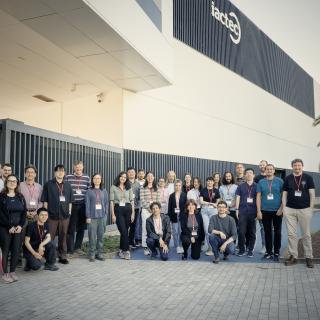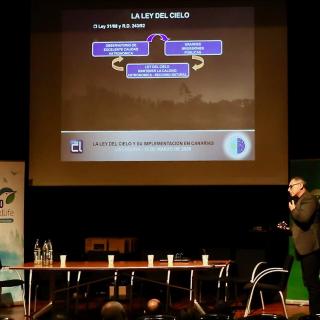The Isaac Newton Group of Telescopes (ING) and the WEAVE instrument team present the first observations with this new instrument. This is a powerful latest generation multi-fibre spectrograph which, in synergy with the Gaia satellite of the European Space Agency (ESA), will be used to obtain spectra of several million stars in the disc and the halo of our Galaxy, permitting in-depth “archaeology” of the Milky Way. In addition, other galaxies, both nearby and distant, will be studied, some of them detected by the LOFAR radio telescope, in order to get to know their evolution.
WEAVE, on the William Herschel Telescope (WHT), at the Roque de los Muchachos Observatory (ORM) on the peaks of Garafía, on the Island of La Palma, has recently been commissioned and is now producing high-quality data. Its first observations were made with the large integral field unit (LIFU), one of WEAVE’s three fibre systems. When the LIFU is used, 547 closely packed optical fibres transmit light from a hexagonal area on the sky to the spectrograph, where it is analyzed and recorded.
The LIFU was pointed at NGC 7318a and NGC 7318b, two of the five objects within Stephan’s quintet, a group of interacting galaxies that has previously been observed by space telescopes such as Hubble, Spitzer and Chandra, and recently with the James Webb Space Telescope (JWST). It is also famous because of its role in the Christmas cinema production It’s a Wonderful Life, in 1946.This group of galaxies, at a distance of 280 million light years towards the constellation of Pegasus is undergoing major collisions between its galaxies, and offers a natural laboratory to study the consequences of galaxies collisions on galaxy evolution.
Gavin Dalton, the Principal Investigator of WEAVE, says, “The richness of the complexity shown in this way by a single detailed observation of this pair of galaxies will offer information about the interpretation of the many millions of spectra which WEAVE will obtain of spectra in the distant universe, and will be an excellent illustration of the power and flexibility of the WEAVE instrument.”
Scott Trager, Project Scientist for WEAVE noted that “These observations show the power of WEAVE to unravel the complex phenomena involved in the evolution of galaxies throughout the history of the Universe. The more than 500 members of the WEAVE Science Team and the members of the wider ING community will certainly make great discoveries with WEAVE’s exciting new capabilities.
J. Alfonso López Aguerri, the Spanish Principal Investigator of WEAVE at the IAC explains, “The WEAVE project has enabled Spanish companies to contribute to the design and development of important parts of the instrument. This has let them gain experience in front-line technological aspects, and positioned them for future projects within large scientific infrastructures.”
WEAVE in the IAC
In the coming 5 years, the ING will commit 70% of its available observing time on the WHT to eight major surveys with WEAVE, which have been selected from among those proposed by the astronomical communities of the member countries. These studies will need the spectra of several million stars and galaxies, an objective which has now been brought within reach thanks to the capacity of WEAVE to observe almost 1000 objects at a time.
More than 500 astronomers from across Europe have organized these eight important surveys using WEAVE, covering the science of stellar evolution, the Milky Way, the evolution of galaxies in general, and cosmology. Several of these surveys are led by IAC scientists. J. Alfonso L. Aguerri explains that the WEAVE surveys will provide answers to key questions such as the role of the cosmic environment on the formation and evolution of the galaxies. This will be particularly true for low-mass galaxies, which are very numerous in the universe, and which will be observable using WEAVE in large quantities, due to the major capacity of the new instrument for the acquisition of data from astronomical objects.
Sergio Simón-Díaz, a member of the WEAVE-SCIP survey, says: "This survey will be the first worldwide that will allow us to extract detailed information about the physical properties of tens of thousands of massive stars in our Galaxy. These observations will be key to better understand the formation and evolution of stars that are born with between 10 and 100 times the mass of our Sun, being both the main generators of oxygen in the Universe and the precursors of events of great interest in modern astrophysics such as supernova explosions and gravitational wave emissions.”
Jesús Falcón Barroso, lead of the WEAVE-Apertif survey, says, "WEAVE-Apertif, in particular, will offer a radically different view of hundreds of galaxies in the nearby Universe. The combination of Apertif's neutral hydrogen data with those from WEAVE's integral field unit in the optical will allow us to establish the role of the environment in the transformation and evolution of galaxies in general. In addition, the high-resolution data from WEAVE are the ultimate tool for unveiling the physical mechanisms that govern the internal dynamics of galaxies, and the characterisation of the dark matter that surrounds them.”
Giuseppina Battaglia, deputy lead of the WEAVE Galactic Archaeology survey, says: "WEAVE is one of the main ground-based projects that will complement the exquisite data from the Gaia space mission by obtaining spectra in the millions of those stars in the Milky Way that are too faint for the Gaia Radial Velocity Spectrograph. These data will address several key open questions about the evolution of the Milky Way, how its stellar components have formed, and the characteristics of its dark matter halo.”
The scientific exploitation of the data obtained will foster the collaboration of IAC researchers with other centres in Europe, and will allow for the production of a large number of PhD theses and cutting-edge research at postdoctoral level.




